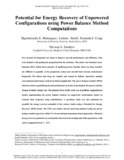JavaScript is disabled for your browser. Some features of this site may not work without it.
| dc.contributor.author | Mutangara, Ngonidzashe E. | |
| dc.contributor.author | Smith, Lelanie | |
| dc.contributor.author | Craig, Kenneth J. | |
| dc.contributor.author | Sanders, Drewan S. | |
| dc.date.accessioned | 2021-10-13T15:26:57Z | |
| dc.date.available | 2021-10-13T15:26:57Z | |
| dc.date.issued | 2021-07-30 | |
| dc.identifier.citation | Mutangara NE, Smith L, Craig KJ, Sanders DS. (2021) Potential for energy recovery of unpowered configurations using power balance method computations. Journal of Aircraft, Volume 58, Issue 6, November 2021, pp.1364-1374 | en_UK |
| dc.identifier.issn | 0021-8669 | |
| dc.identifier.uri | https://doi.org/10.2514/1.C036172 | |
| dc.identifier.uri | https://dspace.lib.cranfield.ac.uk/handle/1826/17158 | |
| dc.description.abstract | New aircraft developments are made to improve aircraft performance and efficiency. One such method is integrating propulsion into the airframe. This allows for boundary-layer ingestion, which shows promise of significant power benefits. However, these benefits are difficult to quantify as the propulsion system and aircraft body become meticulously integrated. The thrust and drag are coupled and cannot be defined separately, making conventional performance analysis methods inapplicable. The power balance method (PBM) addresses this by quantifying aircraft performance in terms of mechanical flow power and change in kinetic-energy rate. The primary focus of this work was to perform computational studies implementing the PBM on unpowered aerodynamic bodies to evaluate their respective drag contributions. A secondary study was also conducted to quantify the energy recovery potential of various bodies using a potential for energy recovery factor. The computational fluid dynamics case studies showed that drag obtained using the PBM agreed to within 2% of conventional momentum-based approaches. Maximal energy recovery potential was consistently observed at the trailing ends of the geometries, with values ranging between 9 and 12%. | en_UK |
| dc.language.iso | en | en_UK |
| dc.publisher | AIAA | en_UK |
| dc.rights | Attribution-NonCommercial 4.0 International | * |
| dc.rights.uri | http://creativecommons.org/licenses/by-nc/4.0/ | * |
| dc.subject | Energy Recovery | en_UK |
| dc.subject | Laminar Separation Bubble | en_UK |
| dc.subject | Kinetic Energy | en_UK |
| dc.subject | Aircraft Configurations | en_UK |
| dc.subject | Propulsion System | en_UK |
| dc.subject | Computational Fluid Dynamics | en_UK |
| dc.subject | Aircraft Performance | en_UK |
| dc.subject | Aerodynamic Characteristics | en_UK |
| dc.subject | Natural Laminar Flow | en_UK |
| dc.subject | Spalart Allmaras Turbulence Model | en_UK |
| dc.title | Potential for energy recovery of unpowered configurations using power balance method computations | en_UK |
| dc.type | Article | en_UK |
Files in this item
The following license files are associated with this item:
This item appears in the following Collection(s)
-
Staff publications (SATM) [4367]

